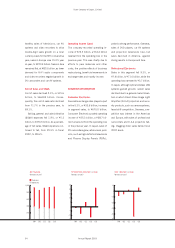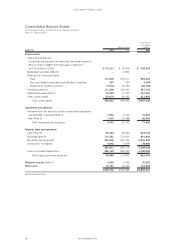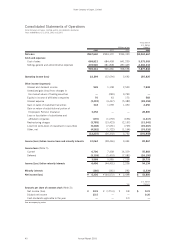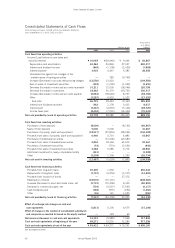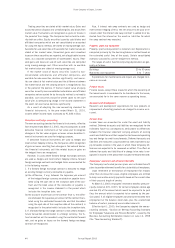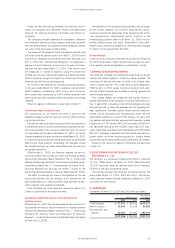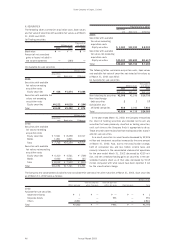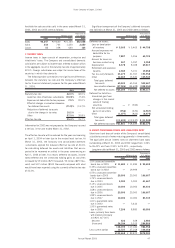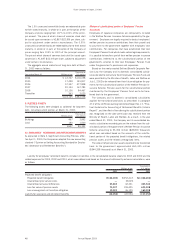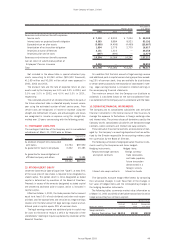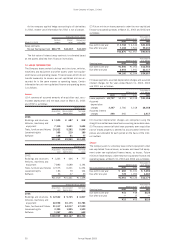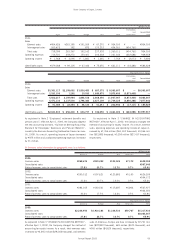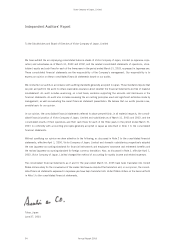JVC 2003 Annual Report Download - page 46
Download and view the complete annual report
Please find page 46 of the 2003 JVC annual report below. You can navigate through the pages in the report by either clicking on the pages listed below, or by using the keyword search tool below to find specific information within the annual report.
Victor Company of Japan, Limited
44 Annual Report 2003
Trading securities are stated at fair market value. Gains and
losses realized on disposal and unrealized gains and losses from
market value fluctuations are recognized as gains or losses in
the period of the change. The Companies had no held-to-matu-
rity debt securities. Equity securities issued by subsidiaries and
affiliated companies which are not consolidated or accounted
for using the equity method, are stated at moving-average cost.
Available-for-sale securities with available fair market values are
stated at fair market value, Unrealized gains and unrealized
losses on these securities are reported, net of applicable income
taxes, as a separate component of shareholders’ equity. Real-
ized gains and losses on sale of such securities are computed
using moving-average cost. Other securities with no available
fair market value are stated at moving-average cost.
If the market value of equity securities issued by non-
consolidated subsidiaries and affiliated companies, and
available-for-sale securities, declines significantly, such securi-
ties are stated at fair market value and the difference between
fair market value and the carrying amount is recognized as loss
in the period of the decline. If the fair market value of equity
securities issued by non-consolidated subsidiaries and affiliated
companies not accounted for by the equity method is not readily
available, such securities should be written down to net asset
value with a corresponding charge in the income statement in
the event net asset value declines significantly.
As a result of adopting the new accounting standard for
financial instruments, in the year ended March 31, 2001,
income before income taxes increased by ¥1,484 million.
Derivatives and hedge accounting
The new accounting standard for financial instruments, effective
from the year ended March 31, 2001, requires companies to state
derivative financial instruments at fair value and to recognize
changes in the fair value as gains or losses unless derivative fi-
nancial instruments are used for hedging purposes.
If derivative financial instruments are used as hedges and
meet certain hedging criteria, the Companies defer recognition
of gains or losses resulting from changes in fair value of deriva-
tive financial instruments until the related losses or gains on
the hedged items are recognized.
However, in cases where forward foreign exchange contracts
are used as hedges and meet certain hedging criteria, forward
foreign exchange contracts and hedged items are accounted for
in the following manner:
1. If a forward foreign exchange contract is executed to hedge
an existing foreign currency receivable or payable,
(a) the difference, if any, between the Japanese yen amount
of the hedged foreign currency receivable or payable trans-
lated using the spot rate at the inception date of the con-
tract and the book value of the receivable or payable is
recognized in the income statement in the period which
includes the inception date, and
(b) the discount or premium on the contract (that is, the differ-
ence between the Japanese yen amount of the contract trans-
lated using the contracted forward rate and that translated
using the spot rate at the inception date of the contract) is
recognized in the period which includes the inception date.
2. If a forward foreign exchange contract is executed to hedge a
future transaction denominated in a foreign currency, the fu-
ture transaction will be recorded using the contracted forward
rate, and no gains or losses on the forward foreign exchange
contract are recognized.
Also, if interest rate swap contracts are used as hedge and
meet certain hedging criteria, the net amount to be paid or re-
ceived under the interest rate swap contract is added to or de-
ducted from the interest on the assets or liabilities for which
the swap contract was executed.
Property, plant and equipment
Property, plant and equipment is stated at cost. Depreciation is
computed primarily by the declining-balance method based on
the estimated useful lives of the assets. Certain consolidated
overseas subsidiaries use the straight-line method.
The ranges of useful lives for computing depreciation are gen-
erally as follows:
Buildings 20 to 50 years
Machinery and equipment 3 to 7 years
Expenditures for maintenance and repairs are charged to in-
come as incurred.
Finance leases
Finance leases, except those leases for which the ownership of
the leased assets is considered to be transferred to the lessee,
are accounted for in the same manner as operating leases.
Research and development
Research and development expenditures for new products or
improvement of existing products are charged to income as in-
curred.
Income taxes
Income taxes are accounted for under the asset and liability
method. Deferred tax assets and liabilities are recognized for the
estimated future tax consequences attributable to differences
between the financial statement carrying amounts of existing
assets and liabilities and their respective tax bases and operating
loss and foreign tax credit carry forwards. Deferred tax assets and
liabilities are measured using enacted tax rates expected to ap-
ply to taxable income in the years in which those temporary dif-
ferences are expected to be recovered or settled. The effect on
deferred tax assets and liabilities of a change in tax rates is rec-
ognized in income in the period that includes the enactment date.
Employees’ severance and retirement benefits
The Company has funded pension plans and unfunded benefit
plans to provide retirement benefits for substantially all employees.
Upon retirement or termination of employment for reasons
other than dismissal for cause, eligible employees are entitled
to lump-sum and/or annuity payments based on the current rates
of their pay and length of service.
At March 31, 2000, employees’ retirement benefits were prin-
cipally stated at 40% (100% for certain employees whose age
reached 55) of the amount which would be required to be paid
(less the amount which is expected to be covered by the pen-
sion plans) if all eligible employees voluntarily terminated their
employment at the balance sheet date, plus the unamortized
balance of certain previously accumulated amounts.
Effective April 1, 2000, the Companies adopted the new ac-
counting standard, “Opinion on Setting Accounting Standard
for Employees’ Severance and Pension Benefits”, issued by the
Business Accounting Deliberation Council on June 16, 1998
(the “New Accounting Standard”).


